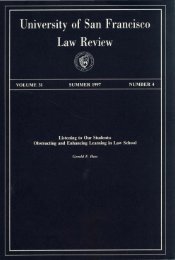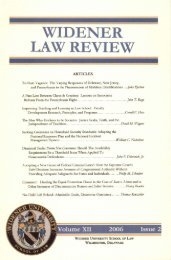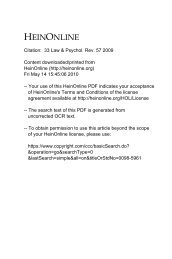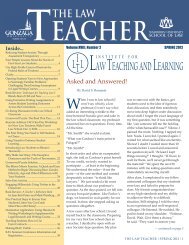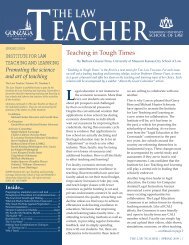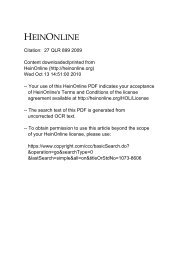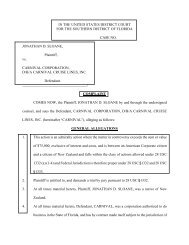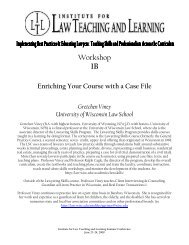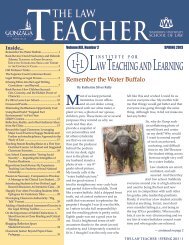Teaching the Law School Curriculum - Institute for Law Teaching ...
Teaching the Law School Curriculum - Institute for Law Teaching ...
Teaching the Law School Curriculum - Institute for Law Teaching ...
You also want an ePaper? Increase the reach of your titles
YUMPU automatically turns print PDFs into web optimized ePapers that Google loves.
Property 341<br />
hitting practice shots on <strong>the</strong> driving range and putting green (pre-class preparation, including case briefing);<br />
watching current tour players both in person and on television or video (hornbooks); studying Power Golf, a<br />
book by Ben Hogan (a study aid, such as a commercial outline); and receiving tips from each o<strong>the</strong>r (outlines<br />
made by o<strong>the</strong>r students). Three times each year, <strong>the</strong>y will play in a tournament against each o<strong>the</strong>r, and those who<br />
do not make <strong>the</strong> “cut” will be dismissed from <strong>the</strong> academy and will not be eligible <strong>for</strong> <strong>the</strong> pro tour. At <strong>the</strong> end of<br />
three years, all remaining students will play in a final tournament. Those competitors who shoot a certain score<br />
will join <strong>the</strong> tour, and those who do not can join <strong>the</strong> tour only if <strong>the</strong>y shoot a certain score at a later tournament.<br />
I use this obvious analogy to help new students see <strong>the</strong> relative value of <strong>the</strong> study methods available to <strong>the</strong>m.<br />
It would be ridiculous <strong>for</strong> an aspiring pro golfer to rely solely, or even heavily, on watching professionals play,<br />
reading Power Golf, and/or receiving tips from o<strong>the</strong>r aspirants. Yet, law students often take this substandard approach<br />
to <strong>the</strong>ir studies, cutting corners by relying solely on study aids and outlines prepared by o<strong>the</strong>r students<br />
without putting in <strong>the</strong> practice time necessary to develop <strong>the</strong>ir own skills. In short, just as a golf student will need<br />
significant practice time both alone and with an instructor, law students must put in significant pre- and postclass<br />
time studying, dissecting, applying, and reviewing <strong>the</strong> material. O<strong>the</strong>rwise, <strong>the</strong>y will not be properly prepared<br />
<strong>for</strong> <strong>the</strong> rigors of <strong>the</strong>ir exams, <strong>the</strong> bar exam and, most importantly, <strong>the</strong> practice of law.<br />
A few years ago, I had an important revelation while imparting this lesson to my students. We give students<br />
challenging material to read and learn. We have rigorous discussions in class, giving <strong>the</strong> students <strong>the</strong> opportunity<br />
to develop and refine <strong>the</strong>ir legal analytical skills. We give challenging exams at <strong>the</strong> end of <strong>the</strong> semester, which<br />
test, in writing and in a time-pressured environment, <strong>the</strong> students’ knowledge and ability to apply what <strong>the</strong>y have<br />
learned. Finally, we give students <strong>the</strong> grade <strong>the</strong>y earned, which assesses <strong>the</strong> quality of <strong>the</strong>ir per<strong>for</strong>mance, principally,<br />
if not exclusively, on <strong>the</strong> final exam. Although this traditional law school methodology is indispensable, it<br />
includes two significant gaps: we wrongly assume that <strong>the</strong> class experience adequately prepares students to take<br />
written exams and that students will learn <strong>the</strong> proper lessons from <strong>the</strong>ir exams despite receiving little or no substantive<br />
feedback on <strong>the</strong>m.<br />
Regarding <strong>the</strong> first gap, <strong>the</strong> class experience alone does not adequately prepare students <strong>for</strong> exam taking. Both<br />
experiences involve legal analysis, but analyzing material in a group setting is not <strong>the</strong> same as taking a written<br />
exam. Some students excel in one context and struggle in <strong>the</strong> o<strong>the</strong>r. Moreover, in most classes, particularly large<br />
ones, each student is called on perhaps no more than twice a semester and spends <strong>the</strong> rest of <strong>the</strong> time observing.<br />
Although <strong>the</strong> students receive writing instruction in <strong>the</strong>ir legal writing course, that course typically does not<br />
address or test exam taking, which is a skill related to but different from objective and persuasive writing. We<br />
never<strong>the</strong>less throw all students into <strong>the</strong> exam fire with little direct preparation <strong>for</strong> <strong>the</strong> experience. This is akin to<br />
<strong>for</strong>cing <strong>the</strong> golf academy students to play tournaments every three months after playing only one or two practice<br />
rounds and receiving very little individual attention from <strong>the</strong> instructors. <strong>Law</strong> students, particularly those in<br />
<strong>the</strong>ir first semester, need to be tested more often than in one final exam per course.<br />
I have identified and implemented three possible solutions to this problem. The first option is to require firstyear<br />
students to take at least one midterm exam that is graded and returned to <strong>the</strong>m, with feedback, be<strong>for</strong>e <strong>the</strong><br />
end of <strong>the</strong> semester. The second option is to give first-year students a practice exam that <strong>the</strong> professor reviews in<br />
class. These first two proposals will help new students learn <strong>the</strong> art of law exam taking. The third option involves<br />
having <strong>the</strong> professors who teach first-year courses submit essay questions and answer keys to <strong>the</strong> legal writing<br />
professors, who will require <strong>the</strong> students to submit answers <strong>for</strong> a grade in <strong>the</strong> legal writing course. These papers<br />
should be graded on both style and substance. Although <strong>the</strong> papers will not be submitted in <strong>the</strong> substantive<br />
course, <strong>the</strong> students can make appointments to discuss <strong>the</strong> papers with <strong>the</strong> professor who submitted <strong>the</strong> paper<br />
to <strong>the</strong> legal writing program. (To avoid needless complaints, <strong>the</strong> school must implement a policy that <strong>the</strong> substantive<br />
professor will not review or comment on <strong>the</strong> grade given by <strong>the</strong> legal writing instructor.)<br />
Regarding <strong>the</strong> second gap, students often do not know <strong>the</strong> errors <strong>the</strong>y committed on <strong>the</strong>ir exams or how <strong>the</strong>y<br />
could have improved <strong>the</strong>ir per<strong>for</strong>mance. Students who are unaware that <strong>the</strong>y repeat correctable errors unwittingly<br />
develop bad habits, such as frequently making assertions without adequate analysis. For such students, a





